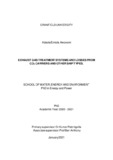JavaScript is disabled for your browser. Some features of this site may not work without it.
| dc.contributor.advisor | Patchigolla, Kumar | |
| dc.contributor.advisor | Anthony, Ben | |
| dc.contributor.author | Awoyomi, Adeola Emiola | |
| dc.date.accessioned | 2024-02-21T14:41:25Z | |
| dc.date.available | 2024-02-21T14:41:25Z | |
| dc.date.issued | 2021-01 | |
| dc.identifier.uri | https://dspace.lib.cranfield.ac.uk/handle/1826/20851 | |
| dc.description.abstract | The shipping industry needs to be decarbonised to below its 2008 levels by 2050 according to the initial strategy set target proposed by the International Maritime Organisation. With fossil fuels having a huge role in the energy space and in particular, the maritime industry, it is paramount that measures to meet this challenge are considered. Carbon capture utilisation and storage is the only technology with the potential to transform fossil utilisation sources into low carbon sources, although their use is not yet established in the shipping industry. Therefore, this research is aimed at evaluating different operational modes and conditions for a ship energy system (manoeuvring, sailing and hotelling) retrofitted with a post combustion capture system. To meet this aim, process models of the ship energy system, capture and liquefaction system were developed in Aspen Plus and benchmarked against literature data available in the public domain. This was done considering ship types powered by both heavy fuel oil and liquefied natural gas at different power requirements (9.8MWe, 7.7MWe, 6MWe and 5MWe). Ship operating worldwide have been required to use fuels with a lower sulfur content as compared to the former situation where sulfur contents of 3.5% were not uncommon. This requirement has been adopted since January 2020. Many researchers have explored sulfuric emissions reduction whilst neglecting carbon emissions. In this research, this issue was resolved by the applicability of a solvent with a multi component handling capacity. Aqueous ammonia was used as the solvent at varying concentrations (<10wt%) and conditions for the powered ship types. A comparison was made between the two fuel systems with regards to the process, economic and weight analysis. It was found out that the heavy fuel oil case resulted in about 12% higher carbon emissions than that of the liquefied natural gas case. The cost of capture was used as the economic index in this study, and about 40% higher was obtained for the heavy fuel oil case compared to that of the LNG. This outcome was traced to the absence of sulfuric emissions in addition to the lower fuel cost. The impact on the ship infrastructure was also investigated in terms of the weight incurred, this was found to be 480 and 356 tonnes for the heavy fuel oil and liquefied natural gas case respectively. The weight accounted for was the installed weight (the solvent and liquid inventory included). Importantly, in ensuring that the ship gets to its required destination, an additional 1MWe was added and this was estimated to be enough for the capture and liquefaction system in all the cases considered. The waste heat recovered from the flue gas served as a thermal source for the solvent regeneration, thereby minimizing power demand needed from the ship energy system. About 70% of the carbon emissions was captured from the flue gas without additional thermal source. Therefore, this research study revealed that carbon capture technologies has the capacity to significantly reduce carbon emissions on a shipping infrastructure taken into consideration additional power demand and related impacts. | en_UK |
| dc.language.iso | en | en_UK |
| dc.publisher | Cranfield University | en_UK |
| dc.rights | © Cranfield University, 2021. All rights reserved. No part of this publication may be reproduced without the written permission of the copyright holder. | en_UK |
| dc.subject | On-board carbon capture | en_UK |
| dc.subject | marine propulsion | en_UK |
| dc.subject | emission control | en_UK |
| dc.subject | chemical absorption | en_UK |
| dc.subject | zero-carbon emissions | en_UK |
| dc.subject | post combustion | en_UK |
| dc.title | Exhaust gas treatment systems and losses from CO₂ carriers and other ship types. | en_UK |
| dc.type | Thesis or dissertation | en_UK |
| dc.type.qualificationlevel | Doctoral | en_UK |
| dc.type.qualificationname | PhD | en_UK |
| dc.publisher.department | SWEE | en_UK |
| dc.description.coursename | PhD in Energy and Power | en_UK |
